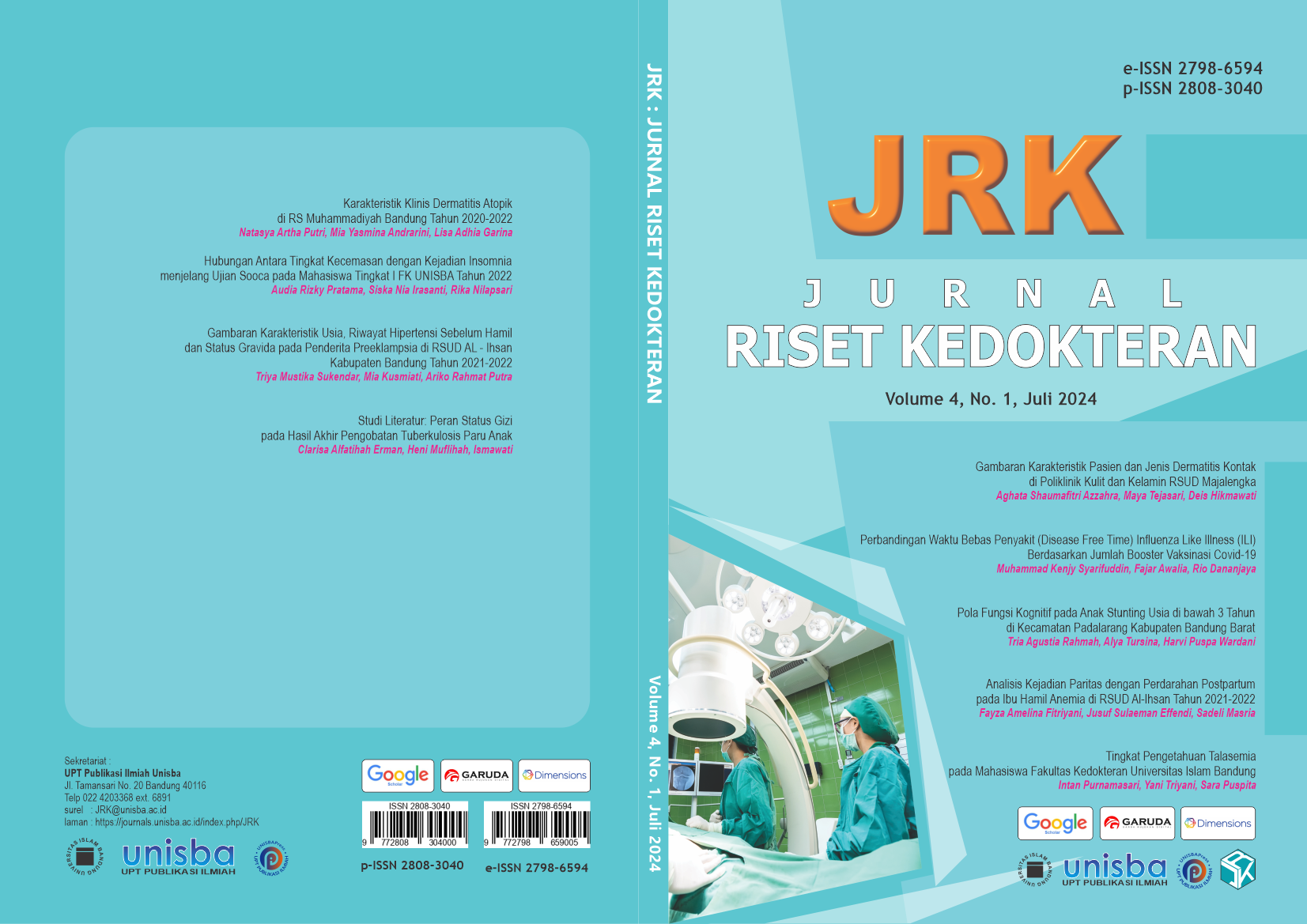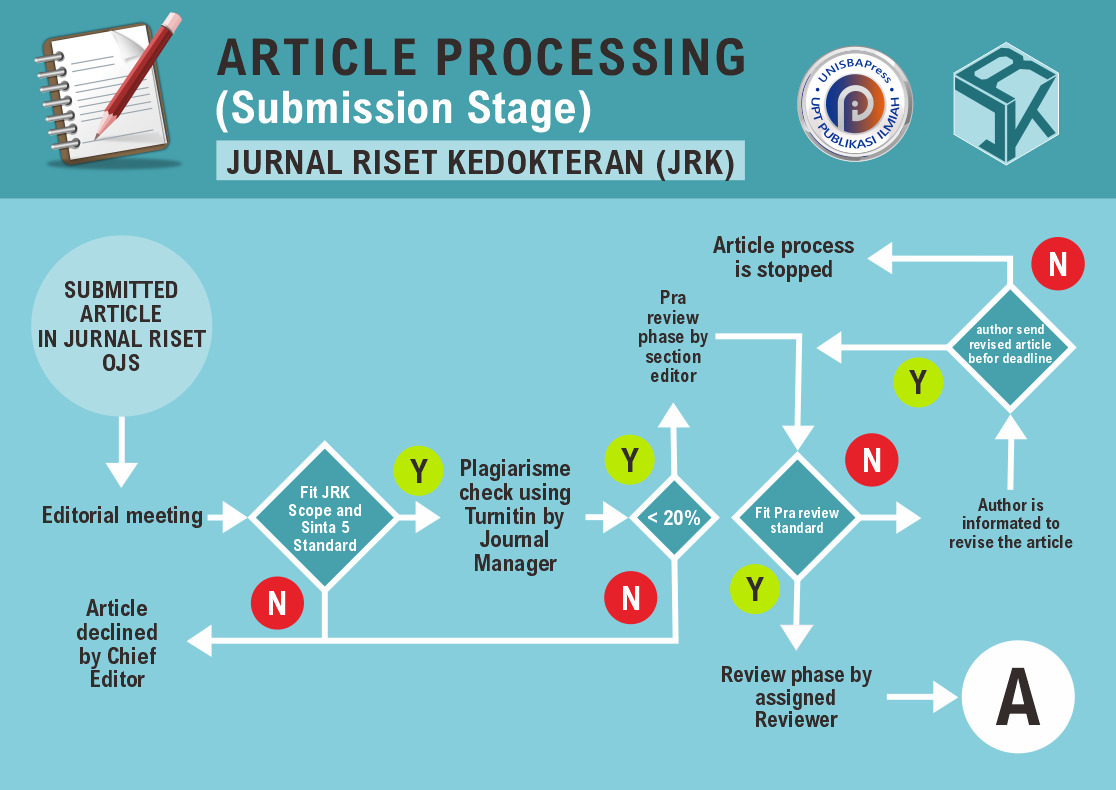Perbandingan Waktu Bebas Penyakit (Disease Free Time) Influenza Like Illness (ILI) berdasarkan Jumlah Booster Vaksinasi Covid-19
DOI:
https://doi.org/10.29313/jrk.v4i1.3708Keywords:
Waktu Bebas Penyakit, Influenza Like Illness, Mahasiswa Kedokteran, Vaksinasi Covid-19Abstract
Abstract. The Covid-19 pandemic that has occurred since 2020 is a catastrophic outbreak experienced by all people in the world, including in Indonesia. One effort to break the chain of spread is by vaccinating. This study aims to determine the comparison of disease free time for Influenza Like Illness based on the number of Covid-19 vaccine boosters. The research subjects were 64 people who were obtained using simple random sampling techniques. This research uses an analytical observational method with a retrospective cohort study approach with survival analysis. The results of this study found that there was a difference in disease free time (P 0.04) between the 1st booster group and the 2nd booster group, where the mean disease free time for the 1st booster group was shorter than the 2nd booster group, the disease free time for the one-time booster group was shorter than the 2nd booster group. booster twice. The group that had never experienced ILI had a median interval between vaccines of 422.4 days while the group that had experienced ILI was 362.5 days. The short time span of the Covid-19 vaccine means that the effectiveness of the vaccine is still high so that it can increase a person's immunity, so that when there is exposure to a virus that attacks a person's body, the frequency and duration of Influenza Like Syndrome is short.
Abstrak. Pandemi Covid-19 yang terjadi sejak tahun 2020 merupakan wabah bencana yang dialami olelh seluruh penduduk di dunia termasuk di Indonesia. Salah satu upaya untuk memutus mata rantai penyebarannya, dengan melakukan vaksinasi. Penelitian ini bertujuan untuk mengetahui perbandingan disease free time Influenza Like Ilness berdasar pada jumlah booster vaksin Covid-19. Subjek penelitian sebanyak 64 orang yang didapat dengan teknik pemilihan simple random sampling. Penelitian ini menggunakan metode observasional analitik dengan pendekatan cohort study retrospective dengan uji kesintasan ( survival analysis). Hasil dari penelitian ini mendapati bahwa Terdapat perbedaan disease free time (P 0.04) antara kelompok booster 1 dan booster 2 kali dimana nilai tengah disease free time kelompok booster 1 lebih pendek dibanding kelompok booster 2, disease free time kelompok booster satu kali lebih pendek dibanding kelompok booster dua kali. Kelompok yang tidak pernah mengalami ILI memiliki median jarak antara vaksin 422,4 hari sedangkan kelompok yang pernah mengalami ILI adalah 362,5 hari. Rentang waktu vaksin Covid-19 yang singkat mengarah kepada efektivitas vaksin yang masih tinggi sehingga dapat meningkatkan kekebalan tubuh seseorang, sehingga ketika adanya paparan virus yang menyerang tubuh seseorang maka frekuensi dan durasi Influenza Like Syndrome yang singkat.
References
World Health Organization. Rational use of personal protective equipment for COVID-19 and considerations during severe shortages.2020Des23.
Cahyyono EA. Sikap masyarakat terhadap program vaksinasi booster covid-19. 2022Jun; 1(1):1-21
Kusyati E, Hapsari S, Widiati A, Wuri Prihatin T, Karya Husada Semarang U. Vaksinasi booster sebagai upaya mempertahankan tingkat kekebalan dan memperpanjang masa perlindungan booster vaccination as an effort to maintain immunity levels and extand protection period. 2022;5:2152-9
Jurnal bhakti civitas akademika. Peningkatan partisipasi masyarakat dalam program vaksinasi booster covid-19. 2022;5(2).46-56
Ria Simanjuntak D, Mamangkey J, Winda Sari Lumban Tungkup N, Izdihar Mahaswari A, Amalia T, Roy Matthew B. Gambaran kejadian ikutan pasca imunisasi COVID-19 pada Mahasiswa Fakultas Kedokteran UKI penyintas Covid-19 dan Non Penyintas COVID-19. 2022.
Wiralodra Jln Ir Juanda Km UH, Barat J, Wiralodra G, Nuraeni T, Pangarsi Dyah Kusuma Wardani S, Nur Purbaningrum D, et al. Penyebab tingginya angka penderita influenza like ilness (ILI) pada Anak: studi kasus di salah satu wilayah kerja UPTD Kabupaten Indramayu. 2021;12(2).
Setiawaty V, Dian Ikawati H.Roselinda. Epidemiology of Influenza-like Illness (ILI) in Java Island, Indonesia in 2011Public Health Research. 2014;4(4):111–6. Available from: https://www.researchgate.net/publication/264045784
Benu F, Usboko I, Seran MSB. Dampak pandemi covid-19 terhadapinteraksi social masyarakat. Jurnal Poros Politik
Murni P, Andrian Beo Y, Nggarang BN, Ruteng P, Yani JJA, Flores R. Hubungan pengetahuan masyarakat tentang covid-19 dengan kepatuhan penerapan protocol Kesehatan di wilayah desa pong leko. 2022Des;7(2):76-84
Puteri AE, Yuliarti E, Putri N, Fauzia AA, Wicaksono YS, Tresiana N. Analysis of the Implementation of the Covid-19 Vaccination Policy in Indonesia. 2022Jun;19(1):122-30
Thomas RE. Is influenza-like illness a useful concept and an appropriate test of influenza vaccine effectiveness? 2014;32:2143–9.
Mengenal Kandungan Vaksin AstraZeneca, Ada Adenovirus Simpanse_. available at https://lifestyle.bisnis.com/read/20210312/106/1366892/mengenal-kandungan-vaksin-astrazeneca-ada-adenovirus-simpanse













